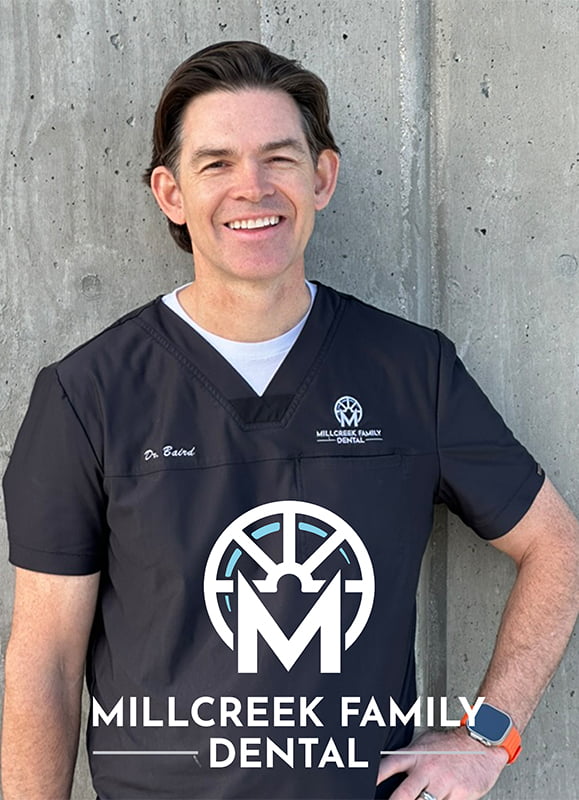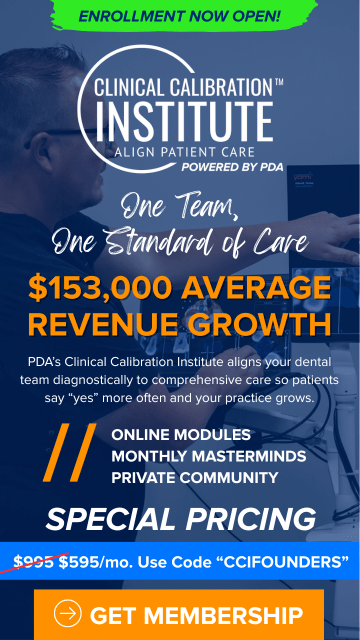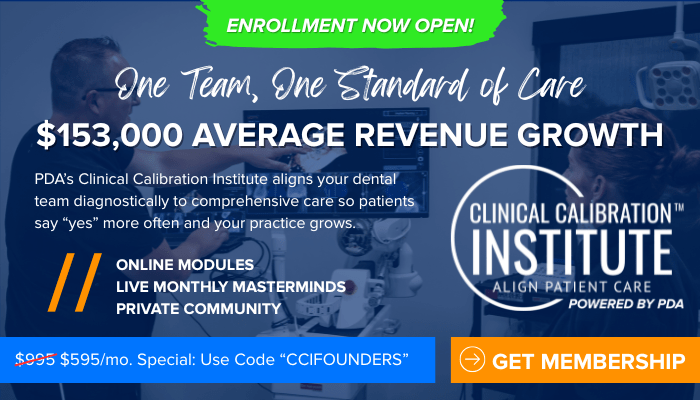Episode 43 – The Insurance Tip that Could Earn You $150,000 with Nicholas Partridge
“Part of having an Investment Grade Practice is having the wherewithal to manage the levers so you can continue to operate successfully.”
– Nicholas Partridge
Would you throw away $150,000 of profit every year?
Of course not. But that’s what you might be doing if you get rid of an insurance plan without asking the right questions.
I get it. As a dental practice owner and clinician, I understand the restrictions you feel from dental insurance companies.
However, if you are building an Investment Grade Practice, you have to look at the longer game. I want to help you build your business by giving you strategies that build durability and decrease risk.
Which is why I’ve invited Nicholas Partridge, Founder and President of Five Lakes Dental Practice Solutions, to join me today for a critical discussion today about how you can craft an insurance strategy that is the most profitable and helps you accomplish your goals. This conversation includes:
- FAQs about insurance top doctors are asking right now
- Smart business questions you need to answer before dropping an insurance plan
- Two real-life scenarios that demonstrate the financial impact of making the smart – but not necessarily obvious – decision about insurance plans
Learn more about Five Lakes Dental Practice Solutions at www.fivelakespro.com.
Want to know if you have an Investment Grade Practice? Click here to use the completely free Investment Grade Practice calculator: What’s my IgP Freedom Number?
Want to have a conversation about your Investment Grade PracticeTM? Contact Brent at brent@productivedentist.com.
Never miss an episode! Subscribe to Investment Grade PracticesTM Podcast on iTunes & Spotify.
EPISODE TRANSCRIPT
Welcome to this episode of Investment Grade Practices. And I’m just wondering, have you ever felt stuck in your current fee schedule or trapped in PPO health? If so then you’re gonna love this episode today I have Nicholas Partridge from Five Lakes Dental Practice Solutions. Nick, it’s so great to have you here. You’ve been working with our clients and we are all personally falling in love with you and what Five Lakes can do for our doctors.
Nick Partridge 2:48
Thank you so much for having me. We feel the same way.
Victoria Peterson 2:52
So let’s dive right into it. This is a you know, pretty fast paced podcast. And so tell us in a nutshell, what does Five Lakes do for dental practices?
Nick Partridge 3:03
So we help dental practices, develop and implement and manage on a go forward basis and insurance participation strategy. And I say that because everybody’s trying to do different things, right, whether you’re a group and you’re trying to bring practices together, and they each have their own insurance participation, or whether you’re trying to whether you’re at capacity, and you’re and you’re thinking about maybe leaving plans, whether you’re fee for service, and you’re thinking about adding some plans because you’re adding an associate or you want to bring up the volume, you know, everybody’s at different points in their journey. And so we help people, dental practices, dental groups develop and manage an insurance participation strategy.
Victoria Peterson 3:47
I’m so glad you said that, because I am not personally one that thinks insurance is the evil empire. I think that it serves a purpose. And on one level, how Blessed are we as an industry that there is something subsidizing the care for our customers, right? We’re not a five star restaurant, no one gets, you know, a steak insurance plan. I wish they did, because I would go out to eat. So on the one hand, I do know that 68% of patients come when they have an insurance plan. On the other hand, being an office manager and a clinician, I know the restrictions that you feel for treatment planning and delivery. So it’s it’s one of those things. You said something so potent when you said it’s an insurance participation strategy. So it sounds like it depends on where you’re at in your life cycle on what’s appropriate. So you probably don’t have any blanket advice for us today. Do you?
Nick Partridge 4:49
You know, we’re really an insurance agnostic, right. Like you said it’s a tool right? And so if you take a step back and use and you ask yourself, you know what is a dental benefit A dental benefit was created to do two things. One is encouraged people to go to the dentist. And two is to help them offset the cost of care. And it’s really fantastically successful at doing that. Right now, like you said, there’s all kinds of cost containment parameters, you know, that they put in place, whether it be limitations on frequency, or, you know, bundling of, of services, they say this is, you know, part of that procedure or whether it’s the network itself and the reimbursement rates, there’s all kinds of different cost containment measures. But statistics show that people with a dental benefit are two and a half times more likely to go to the dentist, right? And everybody says the cost of care is the number one barrier, right? That helps offset the cost. So So you have to take it for what it’s worth, right? And you say, Okay, well, based on what I’m trying to do in my practice, based on what I’m trying to do, you know, where I’m at, you know, you can use insurance to help build your business, right. And so, so that’s what we try to do is we try to use insurance to help attract patients retain patients, you know, address reimbursements, you know, but there’s a lot of different things you’re trying to do in a business. And so it’s just one of the tools now, it’s very complex, and it’s ever changing, right. But nonetheless, it’s still a tool that you can use in your business, depending on what you’re trying to do.
Victoria Peterson 6:22
All right. I love it. Can I ask you some of the most frequently asked questions I get, or some of the things that we see when we’re analyzing practices.
Nick Partridge 6:32
100%? Yeah, sure. All right. Let’s go. Let’s do it.
Victoria Peterson 6:36
All right. Number one, this might be like Nick’s top 10. And you can jump in here to number one, is there still confusion about whether I report to the insurance companies my usual and customary fee and take a ride off? Or do I load the current insurance plan fee schedule and just report to them? What they say they will pay? I was working with a client this week, and they had not changed their fees in 15 years. And they’re really disappointed that Delta Dental is not paying them any more than they have in 15 years, yet they’ve never submitted their UCR.
Nick Partridge 7:14
Yeah, and that’s really the problem, right? So you should always submit your UCR. And the reason for that is there’s there’s several but I think the biggest thing is you’re declaring this is what I charge for this procedure in my office, right? So you’re declaring that to the insurance company saying, hey, look, this is where I’m at. And the insurance companies want to offer if you’re in a PPO network, they want to offer a discount to their members. And so they can see where you’re at. And then you can come back and say, Hey, this is where the contract rate is. And then you’ve got room to talk about the distance between them, right? But if you’re only ever filing your contract rates, number one is that’s going to put you in some legal troubles, because then you’re charging everybody different amounts based on which insurance they have, if that’s your practice, which you can’t do. And number two,
Victoria Peterson 8:03
I get Wait a minute, I didn’t know that. So you can’t just send United united and Blue Cross Blue Cross and be compliant, you’re out of compliance if you’re out of
Nick Partridge 8:12
compliance. Yeah, because what you’re essentially doing then so like, let’s say, for example, for a profi. If you have a United Healthcare fee schedule that says maybe that profit is $70. But then, and you’re charging UnitedHealthcare, 70. But then for MetLife, if it’s 50, and you’re charging MetLife, 50. If United Healthcare were to find out about that, you’ve been essentially overcharging their patients. $20. Right? Because hot water? Oh, very much. So yeah. So you have to charge everybody the same regardless, right. And that’s, that’s kind of a general rule of thumb. And so, so the easiest way to do that is to build your UCR, you build your UCR, then you can disclose to the insurance companies that hey, look, you know, you want me to take a discount, this is too much of a discount, here’s where you’re at, here’s where I’m at, let’s, let’s talk, you know, so it gives you gives you some latitude
Victoria Peterson 9:00
and love that. No, I have also heard about, I’m going to call them pop up groups, for lack of better word, but I hear about we’re starting a group and we’re gonna go to the, to the insurance companies together as 15 or 20 dentist who otherwise don’t know each other, but we’re gonna go and get leverage on them. Does that work?
Nick Partridge 9:25
You know, it’s interesting. There’s so much that’s going there’s so much gamesmanship in this right, in the sense that everybody is trying to, to find an angle to do things and and I think if you take a step back at the end of the day, you have to understand what the spirit of the arrangement is right? That you’re willing to accept a discounted rate as payment in full exchange for the opportunity to be able to attract more, you know, disproportionately more patients from that network than you would maybe if you were out of network, right. And so When you try to get real cute, and play games to upset that, the spirit of that agreement, I think you might be, you know, run into some issues. If you’re really, truly forming a group, for the purposes of achieving leverage, not only with payers, but with suppliers and labs and things like that, I think that makes total sense. And that’s why you’re, that’s one of the many reasons that you’re seeing this consolidation in the dental industry, is just because, you know, fragmented industries, tend to be fairly inefficient, right. And so, so So we see that in the dental industry, and that’s, that’s changing now, as a result of a lot of different factors. You know, I think, going to I’ve seen this, when I see we’ve seen some groups where they buy, like, two practices in Maryland, and two practices in Michigan, and two practices in Texas. And they come to us and they say, Well, we’ve got 20 practices, you don’t have scale anywhere. Right? Right. You know, and so my advice, if you’re trying to build a company, with the purposes of achieving leverage with specifically payers, would be to build density in the market, because you’re more valuable from that respect, you know, and probably from an administrative operational perspective, that well, you don’t have field, you don’t feel directors of operations, you know, flying from here to there trying to take care of the two offices here. And the two offices there. And, you know, so I just I don’t I don’t know that I would form a group specifically for the purposes of negotiating. Because, again, it depends on now, there’s just so many factors that, you know, there’s so many factors,
Victoria Peterson 11:39
it doesn’t feel like there’s enough stickiness there. Right, that, that the, it’s just on paper anyway. So we’ll move on, we’ll keep moving forward. These are just some of the fun things that pop up. Okay. So there used to be, and maybe there still is a way for patients to opt out of filing insurance or to have a HIPAA form or something like that, that they could send to the payer saying, I choose not to have my dentist, even though they’re in network, I choose to not have my dentist file for this particular procedure, and I accept their full fees, that the thing
Nick Partridge 12:21
is, you can still do that. I have less than less I hear about it. But it’s one of those things where, you know, as a patient, I just I don’t understand why, you know, like, as a doctor, you know, I mean, the other thing is, too, is like, if you’re trying to get your full fee,
Victoria Peterson 12:40
like get the point of it, let’s say that it’s a $15,000 treatment plan. And the terms of the contract, say you can’t build more than $1,500 and their plan limitations. Yeah. But there’s a $14,000 spread here. So patient opt out, and then we can do the treatment. Is that the I’m throwing you curveballs. Yeah, no, but
Nick Partridge 13:00
so it’s a good question. But a lot of times the rule of the language is more that even if you’ve consumed your maximum for the year, you’re, you’re still eligible for the discounts thereafter, right. And so so if you have a $3,000 treatment plan, and you consume your 1500, maximum from insurance, the next $1,500 still has to be at that discounted rate, right? Because it’s even though you’ve run out of benefits, it’s still an applicable service under the benefit, you know, so you have to be careful of those kinds of things.
Victoria Peterson 13:34
Thanks for letting me throw you these curveballs, you know,
Nick Partridge 13:39
it’s great. It’s great to get into a room here where we can just talk insurance, nuances, right. And then by
Victoria Peterson 13:48
part of building an investment grade practice is building durability, and decreasing risk. And so I work with a lot of doctors who are beginning the process of succession planning. And hopefully, if they’re doing these kinds of things, they’re three or four years before succession planning, because you want to clean all of this stuff up. You don’t want to have potentially libelous things coming up during a practice valuation. Right. So during the practice valuation, you go through all fee schedules, all insurance, how is that done? And I’m seeing AR, that’s like, out the wazoo, because I’ll take the example which is really common. If you’re deep in a community, be that yachting or golfing or country club or church and you go yeah, just fill what insurance states and we’ll write off the rest. But a they don’t write it off B it stays on accounts receivables and see I don’t think that’s legal. Right?
Nick Partridge 14:48
Well, I love the principle of this other than investment grade practice because to me, that speaks to a a well oiled machine, right. So durable, certainly one of the great word for it, I think you want. A lot of times in a practice, because there’s usually an individual practitioner. From practice to practice, you might see wildly varying behaviors and policies and procedures and practices in the office, let alone fee schedules and participation and things like that. And what you really want is, is good solid thought and methodology that went into it and training for the team and, and you know, it to be a well oiled machine. So I just love what you guys are doing with building investment, great practices.
Victoria Peterson 15:37
I love that. All right, my last little curveball here, then we’ll get into building the durable system part. And you at the body, you can tell like I was an office manager where we had, you know, the four colored pens, and we were hand sending statements to the you know, with a little red pen and color. So can you steal a little tiny font at the bottom of a submission, say this patient has received a courtesy in our office. And that’s kind of a blanket. Now the insurance company has to come and find out from you what that courtesy was or, you know, that keeps you illegal?
Nick Partridge 16:14
Yeah, yeah, absolutely. One of the things that is really important, is that because insurance, you know, and I think there’s also, a couple of things to opine on about this number one is that dental insurance works very different than medical, right. So people’s experience, they come in to the dentist, they think it works the same way, or they expect it to work the same way. And it does not work the same way. Right. So there’s one, there’s an educational component to that and setting the patient expectations up front. Number two is when you come in, because insurance is oftentimes a percentage, it’s a coinsurance, right? So they’re going to pay 80% of treatment, not 80% of a fixed dollar amount, they’re going to pay 80% of a treatment, you know, that you are obligated to, to collect the copay, right, you cannot waive copays, because then the percentage balance is off, right. If you’re going to collect for a procedure, you need to collect $100, and you don’t, then the insurance company ends up paying a disproportionate percentage of the claim, which is in violation of the policy. Right. So that’s one thing. And on top of that, then when you offer courtesy discounts, the insurance company, then likewise should share in that discount, right. So if you’re going to discount something from $100, to $80, the insurance company also then their percentage that they’re going to pay is off the 80, not the 100. You can’t just give the patient the courtesy and make the insurance company pay the full amount. It doesn’t work that invalidates the whole logic and rules. They’re so
Victoria Peterson 17:49
complicated. So so let’s take the moving forward approach. I love what you said, let’s, let’s have an insurance participation strategy that allows you to move forward. So let’s say like a lot of doctors post pandemic, they are at capacity. And patients are saying yes to treatment. It’s like it’s almost unprecedented, right? They’re like, while you’re in here, Doc, just do the whole quad or half mouth or knock me out. Patients are now asking for that. So when you’re at capacity, and we evaluate this every day of the week, and they’re like, I need to hire two more hygienist. I just went through that. And I was like, well, your hygiene salaries, given your write offs are 56% of net production, and you got 30 40% overhead. So right now you’ve got no profit and hygiene. I’m not sure I would hire another hygienist two days a week because it doesn’t, it just makes you busy. It doesn’t make you profitable. So take a scenario like that, where I’m at capacity. How do you start slowly weaning off some of these plans that may not be fitting your current is quite honestly, right, where you sign up the plans when you’re young and your bread and butter and then your clinical elevates, and you stay on them out of habit? When when and how do you reevaluate that right size to capacity?
Nick Partridge 19:12
Yeah, that’s a great question. And we’re dealing with that as well. A lot of clients we have are experiencing what you’re talking about where they’re at capacity, and they’re saying, hey, wait a second, you know, and so I think the questions. So we have a methodology for this, right? And it involves a number of pieces. But like, I think the thing you start with is understanding where you’re getting your patients from today. Right? So what is your patient mix? Because a lot of times people say well go after the lowest fee schedule, but the lowest fee schedule is usually your highest producing plan. Usually it’s like a delta or MetLife. Right? They’re kind of like dealing with Walmart, you know, it’s about volume at low prices, right? That’s kind of what you’re you’re signing up for. And so, you don’t normally just go in and fire your lowest paying, you know, that’s the The approach that we espouse. Right? So we were going to go collect some information, we’re going to look at your patient mix. Where are you where your patients coming from? We want to go through the patient roster itself. And we want to figure out who these people are, you know, we’d hate to do that for the school district, right? Or some source of patients, that would be a huge generator, right? So like, if you’re in an area where there’s a city school district has Cigna, you know, that might not be the first one that we target as well, right? We’re going to be sensitive to that we’re going to go to the patients, hey, what’s the likelihood that these people might stay? Or how long have they been with us? Do they have treatment on the books now? Are they pre appointed for some time in the future, we need to look at those kinds of things, right? Obviously, then we need to look at their fee schedules. And before we start saying, let’s just cleave off this plan. Let’s go back and see if we can’t move them up the ladder, right, before we make our final decision on which plans we’re going to terminate, and in what order, we want to go back and negotiate. Or we want to go back and reconsider how to participate, to see if we can’t move them around, right? Because maybe the answer is that you’re going to turn six of the eight plans that you’re in over the next 24 months. But the order in which you do it may be affected by the fact that you can get more a better reimbursement in the meantime, right? You know, and so there’s some, there’s things like that to consider. When you participate in networks through third parties, they oftentimes will have more attractive fee schedules. But they’ll only access you only access a portion of the patient base, right. So if you participate, for example, with picking on MetLife again, here, but MetLife through a third party, like a connection Dental, only the PDP plus and FEDVIP members are considered in network. So you can kind of take a step wise out without going fully out right? Or so there’s different things you can do. Like Cigna has two networks, Delta has two networks, you can say, well, I want to do that network and not that network. So there’s a lot of different variables to consider before you put a final plan in place. What regardless of the when we do it, one thing that we’re always looking for that is that that feedback loop, right, so we say, hey, look, see what this does to your new patient flow, right? And see, and let’s make sure the office is trained and understanding how to answer the phone, because right now, they’ve been answering the phone as yes, we’re in network for everything. And now that’s not the case, right. And so we’ve got a master that conversation. And we’ve got to be prepared with objections that we might face from our existing patients who are now out of network for. And so we’ve got to be comfortable as a team, talking about those things and working through those objections. And then we’ve got to look and see what that does to our schedule. Do all of a sudden, we have a lot of cancellations. Do we have people not reappointing? Do we have the calls slowed down, right? Because we don’t want to keep on our path to terminating when maybe that’s the realities of our business are changing, right? So there’s this constant feedback loop that you’re looking for along the way. And also, in doing this, you’re looking and saying, Well, we thought maybe we would keep 60% of the patients, we only kept 30%? How does that affect our next decision? Right? So there’s things like that, that you’re constantly looking at. So it’s, it’s very data driven, as opposed to, you know, hey, this claim, didn’t pay the way I wanted it to. And it’s took us three weeks to get it and let’s just terminate it right, you know, so because one of the things that I think is really important understand is people don’t go to the dentist, like they go to the grocery store. Right? I only go twice a year, right? And so you may not realize the impact of a decision, like I read these posts online to say, I just dropped everything. Things are going great. And I haven’t noticed any difference, like in the first week or two. It’s like, well, that’s that that’s not going to materialize for 10 or 15 months. Yeah, right. So you’ve got to kind of do it slowly. And, you know, because it takes a long you can, you can destroy something much faster than you can build it. Right. So you definitely want to move slowly, you want to move methodically, you want to be aware of all the inputs and make sure that you’re and that’s really part of being an investment grade practices, is having the wherewithal to manage those levers, right, the visibility and the wherewithal to manage those levers so that you can continue to operate successfully.
Victoria Peterson 24:23
I love that we’ve had, I mean, so many of our doctors because they’re comprehensive, and they diagnosed by risk factors, and they’ve got a well educated patient base, but that takes years, you know, sometimes to develop a well educated patient base that are referring other well educated and getting the marketing we always say insurance is a marketing plan. So I love you just gave me I’m going to start tracking the ROI. We track the write offs, but I want to track the ROI. And when I had practices in Wisconsin, we had one insurance that the The teams were always complaining about what we knew we wouldn’t drop it. So it was TRICARE with the military. Oh, yeah, right. Worst hairs ever. But when we went in and analyzed it, the military personnel weren’t the people coming in our office, it was their spouses and children. And we were out of network for that. And so we would have lost like $150,000 in profit from the extended family that was coming in, had we dropped it. So yes, it was a high write off, but it was a very small percentage of our patient base that came in. So the military personnel, and then we got the by the families. So we were like, Whatever, let’s have a make a fun thing of it. Who cares about the write offs? This is bringing good revenue. So it’s, it’s about the quality of revenue, and how sometimes I think the conversation is becoming, how does the quality of revenue align with my core values. So if it and that was one of our core values in that area was to take care and honor our military and our veterans? So there was no way we were dropping that plan? We just needed to make it work with our overhead.
Nick Partridge 26:13
Yeah. And like you said, venue turned into a nice marketing activity, say ever, you know, today’s military Day everyone coming in, you know, I think it’s really important because, you know, if you’re a group or you’re somebody looking to go through a transition, they always do a quality of earnings. Right, right. And so quality of earnings is what’s left, you know, you bring money in, you spend money, and then here’s what’s left, right. But very few people understand the nuances of revenue. Right. You know, your accountants are really good at understanding how much what percentage of your revenue you should spend on labor and supplies. And I mean, there’s, there’s percentages, right? There’s ranges that everyone gets three, three to 5%, on labs and whatever, right. But very few people have a good understanding about how revenue turns up on the on the profit and loss statement, right? You know, so because it’s coding, it’s billing, it’s collections, it’s your UCR, it’s your insurance reimbursement rates, it’s the plans in which you participate. It’s your ability to sell treatment, right, you know, is there’s so many different factors to it. That, you know, when we look at this, like I was talking to a friend the other day, and the ATA came out with the new code for cleanings, right, it was I forget what the code is, it’s 4346, or something like that, right, like three or four years ago. And so we just did a quick look at our, our client base. And in 2000 practices that we manage insurance participation for less than 5% of of them are using that code. Right, but it reimburses at a different rate than just a standard prophy. Right. And so there’s just a lot of things like that, like, if you started using that code when you when it was appropriate, then, you know, I don’t know how much let’s say it’s an extra couple. $1,000. Right, you know, so there’s just so quality of revenue is something that really, when you said that I was like, Oh, I triggered?
Victoria Peterson 28:08
Yes. I love that you said there’s a nuance or revenue, and you’re right, it is the it’s perseverance, it’s it’s for your financial coordinators to know that all your claims are gonna get rejected first time. It’s a great, it’s a narrative and a better narrative and an x ray. And, yeah,
Nick Partridge 28:31
yeah, you got to know this, you know, like an investment grade practice would know what the narratives requirements are. Right? You know, so because they have a well oiled revenue cycle.
Victoria Peterson 28:42
Do you offer classes and coding classes and things like that? What resources do you have for we don’t
Nick Partridge 28:48
we work with a couple of partners that do some of that stuff. But we we identify because we look at production, because it obviously influences our efforts from a negotiations perspective. If two practices come to us, they have this exact same fee schedule from say, Cigna, it might mean different values to them, because of the codes that they use right more frequently. So if you don’t have a very strong hygiene program, or perio program, you know, that may change things if you’re marketing to an older population and doing a lot of restorations, you know, that fee schedule may be more or less valuable, valuable to you. So we look at production, because it really affects our decision making. And we can identify where we think maybe there’s things that are inconsistent or out of line, because you might imagine this dental utilization is pretty predictable in a large group. So when we look at a dental practice, if we saw that, you know, there were no fillings and only crowns, you know, that would raise a red flag, right? That would be problematic if we see that there’s not a lot of perio that’s probably you know, we say okay, there’s an opportunity there, but we don’t get into helping you like, you know, nuance or diagnose more or Yeah, document more. Right? Yeah. So we turn that over to partners.
Victoria Peterson 30:03
I love that. I love that. If you were working with a doctor today that said, I really want to go towards? Well, we’ve answered the question about fee for service, it takes time, and you’ve got to analyze the plans and get a strategy. But what if they were adding a, an associate, like I had someone the other day? And I said, Oh, my gosh, you’re writing off like 46% on this planet? It was, was so obvious, even you, I think would drop it for the low, low. And they’re like, no, but we’re getting an associate. And I was like, Do you really want to give your sociopathic hit?
Nick Partridge 30:40
Well, it’s, you know, it’s a good question. So I have the mindset that, and this is not universally adopted, right? So, so there’ll be people that disagree with this, but you need to be at capacity, right? Because you every day, you pay the rent, you pay for your malpractice insurance, you know, you have a lot of fixed costs. And so if you have idle chair time, I don’t necessarily focus as much on the write off, because your every dollar that you bring in once you cover your fixed costs is incremental, in value, right? Until the point at which you have to then change your cost structure. Right, right. So when you have to change your cost structure, whether that’s adding an associate, or you know, outfitting another operatory, or, you know, extending your hours, which means your staffs not going to be there longer, or whatever, you know, then then that’s a point that’s a decision point to look and see, what’s the right thing to do. Right, then you’re going to start to factor in, okay, well, what is, you know, what is what does it cost me to operate this facility per hour? What’s the what’s the revenue that I’m bringing in, you know, what are the write offs from the different insurance companies, you just start to look at it at that point. So if you’re at a point right now, where you have idle capacity, I say, Keep, keep bringing patients in, right until you’re full. And when you’re full, before you decide to leave a plan before you decide to add an associate before you decide to do anything else. That’s kind of the decision point to look and see what’s the most profitable thing for you to do? Or what’s in the interest of what you’re trying to accomplish? bigger vision, the longer term.
Victoria Peterson 32:24
It makes so much sense when you lay it out like this. It’s like, Oh, that’s easy. That’s logical. If only, only our emotions didn’t get in the way,
Nick Partridge 32:35
but that’s why you have advisors, right? I mean, that’s why people come to you, it’s why people come to us and because they need help, right? Because they’re not experts in the area, they’re not always thinking about these things clearly. And so they need somebody to kind of help them, you know, think about things objectively, right. And if you say, this is what we’re trying to do, within my sphere of expertise, then this is how I’m gonna, you know, address that. Right. So, and it’s not to tell you what you want to hear either, right. So. So sometimes we get into, you know, some heated discussions about things because, you know, I’m just trying to get you to understand this side of the table right there, you know, so it’s very, yeah, it’s very interesting. That’s what but that’s why I love the field. Right? That’s why I love working in dentistry. You get to work with so many business owners, and in their teams, and you know, and make a real impact.
Victoria Peterson 33:29
I love it. Nick, when my clients say Victoria, what do I need to do about my insurance? I go, I don’t know, let’s call an expert. So how would people get in touch with you to get started kind of evaluating their their plans and putting into place a, you know, a participation strategy?
Nick Partridge 33:49
Sure. Yeah. Best way to do it is probably to go online. Our website is www dot five lakes pro.com. And on there, you can click the Contact Us button, you can send us an email, and we’re up we’re on Facebook and Twitter and all the social places as well and on social media, and we’re out about you know, we’d like to see we like to go out and into shows and see see different folks and so we’re happy to happy to hear what you’re challenged with and see if there’s something we can do to help. All
Victoria Peterson 34:21
right, I’ll make sure that cashmere gets fed into our show notes. Thank you so much for your wisdom I we really packed a lot of golden nuggets into the
Nick Partridge 34:30
videos. I appreciate the questions that was that I liked. There’s just some tough ones me.
Narrator 34:38
Thank you for tuning in to this episode of investment grade practices podcast. If you find value in this episode, help us spread the word by passing it along to a dental friend, subscribe and give us a Like on iTunes or Spotify. Learn more about building your investment grade practice at productive dentists.com Today
Have a great experience with PDA recently?
Download PDA Doctor Case Studies


















